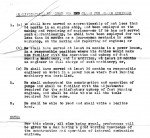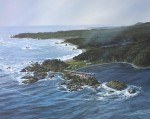– Roy Carver (son of C. E. Carver on Kains Island 1933 – 1944)
One of the daily duties of a light house keeper was to estimate the wind speed during each day and record it, along with other meteorological observations and measurements, which also included sea water temperature, and a sample of sea water which was taken at a depth bellow the surface, weather permitting of course.1

The small glass bottles with cork stoppers of sea water were stored in wooden boxes with many little squares, one for each bottle. These boxes would be shipped out when the supply ship re-supplied the station once a year, usually in July. As far as I know Father never did find out what happened to the bottles of sea water after they left the station.2
For an individual to estimate wind speed is a pretty tall order, especially on the edge of an island. If the wind is blowing in your face one would judge the wind speed higher than if it was blowing from behind you (behind the island), so wind speed estimating was not very accurate, even with the crude wind speed indicating instruments supplied at the station. Continue reading The Wind Speed Indicator Episode c.1935







